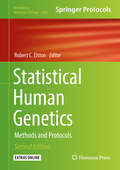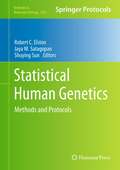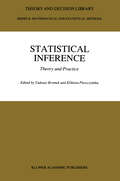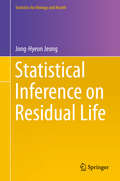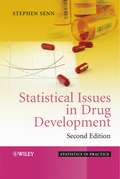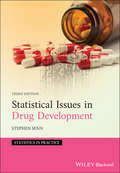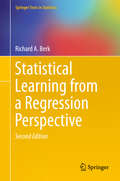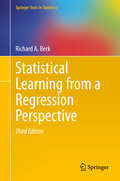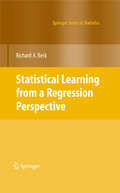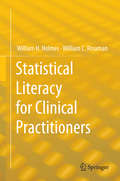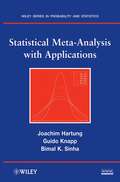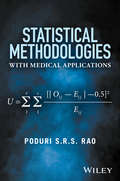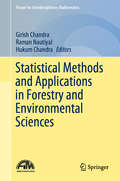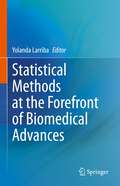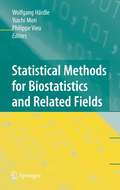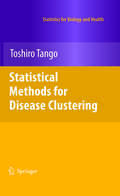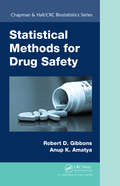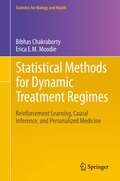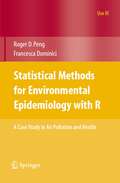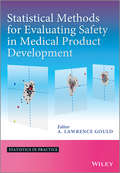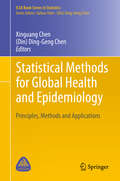- Table View
- List View
Statistical Human Genetics: Methods and Protocols (Methods in Molecular Biology #1666)
by Robert C. ElstonThe aim of this volume is to make computer programs for analyzing human genetic data more easily accessible to the beginner.Statistical Human Genetics: Methods and Protocols, Second Edition provides updated and new chapters detailing genetic terms, analysis software, and how to interpret the program outputs. Written in the highly successful Methods in Molecular Biology series format, the chapters include introductions to their respective topics, step-by-step instructions, and tips on troubleshooting and avoiding known pitfalls. The purpose of Statistical Human Genetics: Methods and Protocols, Second Edition is to ensure successful and meaningful results in the fast-growing field of genetic epidemiology.
Statistical Human Genetics: Methods and Protocols (Methods in Molecular Biology #850)
by Robert C. Elston, Jaya M. Satagopan and Shuying SunRecent advances in genetics over the last quarter of a century, especially in molecular techniques, have dramatically reduced the cost of determining genetic markers and hence opened up a field of research that is increasingly helping to detect, prevent and/or cure many diseases that afflict humans. In Statistical Human Genetics: Methods and Protocols expert researchers in the field describe statistical methods and computer programs in the detail necessary to make them more easily accessible to the beginner analyzing data. Written in the highly successful Methods in Molecular Biology™ series format, with examples of running the programs and interpreting the program outputs, the chapters include the kind of detailed description and implementation advice that is crucial for getting optimal results from human genetic data collected in the laboratory. Thorough and as much as possible intuitive, Statistical Human Genetics: Methods and Protocols aids scientists in understanding the computer programs and analytical procedures they need to use.
Statistical Inference: Theory and Practice (Theory and Decision Library B #17)
by Tadeusz Bromek Elzbieta PleszczynskaUse and misuse of statistics seems to be the signum temporis of past decades. But nowadays this practice seems slowly to be wearing away, and common sense and responsibility recapturing their position. It is our contention that little by little statistics should return to its starting point, i.e., to formalizing and analyzing empirical phenomena. This requires the reevalu ation of many traditions and the rejection of many myths. We hope that our book would go some way towards this aim. We show the sharp conflict between what is needed and what is feasible. Moreover, we show how slender are the links between theory and practice in statistical inference, links which are sometimes no more than mutual inspiration. In Part One we present the consecutive stages of formalization of statistical problems, i.e., the description of the experiment, the presentation of the aim of the investigation, and of the constraints put upon the decision rules. We stress the fact that at each of these stages there is room for arbitrariness. We prove that the links between the real problem and its formal counterpart are often so weak that the solution of the formal problem may have no rational interpretation at the practical level. We give a considerable amount of thought to the reduction of statistical problems.
Statistical Inference on Residual Life (Statistics for Biology and Health)
by Jong-Hyeon JeongThis is a monograph on the concept of residual life, which is an alternative summary measure of time-to-event data, or survival data. The mean residual life has been used for many years under the name of life expectancy, so it is a natural concept for summarizing survival or reliability data. It is also more interpretable than the popular hazard function, especially for communications between patients and physicians regarding the efficacy of a new drug in the medical field. This book reviews existing statistical methods to infer the residual life distribution. The review and comparison includes existing inference methods for mean and median, or quantile, residual life analysis through medical data examples. The concept of the residual life is also extended to competing risks analysis. The targeted audience includes biostatisticians, graduate students, and PhD (bio)statisticians. Knowledge in survival analysis at an introductory graduate level is advisable prior to reading this book.
Statistical Issues in Drug Development (Statistics in Practice #69)
by Stephen S. SennDrug development is the process of finding and producing therapeutically useful pharmaceuticals, turning them into safe and effective medicine, and producing reliable information regarding the appropriate dosage and dosing intervals. With regulatory authorities demanding increasingly higher standards in such developments, statistics has become an intrinsic and critical element in the design and conduct of drug development programmes. Statistical Issues in Drug Development presents an essential and thought provoking guide to the statistical issues and controversies involved in drug development. This highly readable second edition has been updated to include: Comprehensive coverage of the design and interpretation of clinical trials. Expanded sections on missing data, equivalence, meta-analysis and dose finding. An examination of both Bayesian and frequentist methods. A new chapter on pharmacogenomics and expanded coverage of pharmaco-epidemiology and pharmaco-economics. Coverage of the ICH guidelines, in particular ICH E9, Statistical Principles for Clinical Trials. It is hoped that the book will stimulate dialogue between statisticians and life scientists working within the pharmaceutical industry. The accessible and wide-ranging coverage make it essential reading for both statisticians and non-statisticians working in the pharmaceutical industry, regulatory bodies and medical research institutes. There is also much to benefit undergraduate and postgraduate students whose courses include a medical statistics component.
Statistical Issues in Drug Development (Statistics in Practice)
by Stephen S. SennStatistical Issues in Drug Development The revised third edition of Statistical Issues in Drug Development delivers an insightful treatment of the intersection between statistics and the life sciences. The book offers readers new discussions of crucial topics, including cluster randomization, historical controls, responder analysis, studies in children, post-hoc tests, estimands, publication bias, the replication crisis, and many more.This work presents the major statistical issues in drug development in a way that is accessible and comprehensible to life scientists working in the field, and takes pains not to gloss over significant disagreements in the field of statistics, while encouraging communication between the statistical and life sciences disciplines. In addition to new material on topics like invalid inversion, severity, random effects in network meta-analysis, and explained variation, readers will benefit from the inclusion of:A thorough introduction to basic topics in drug development and statistics, including the role played by statistics in drug developmentAn exploration of the four views of statistics in drug development, including the historical, methodological, technical, and professionalAn examination of debatable and controversial topics in drug development, including the allocation of treatments to patients in clinical trials, baselines and covariate information, and the measurement of treatment effectsPerfect for life scientists and other professionals working in the field of drug development, Statistical Issues in Drug Development is the ideal resource for anyone seeking a one-stop reference to enhance their understanding of the use of statistics during drug development.
Statistical Issues in Drug Development (Statistics in Practice)
by Stephen S. SennStatistical Issues in Drug Development The revised third edition of Statistical Issues in Drug Development delivers an insightful treatment of the intersection between statistics and the life sciences. The book offers readers new discussions of crucial topics, including cluster randomization, historical controls, responder analysis, studies in children, post-hoc tests, estimands, publication bias, the replication crisis, and many more.This work presents the major statistical issues in drug development in a way that is accessible and comprehensible to life scientists working in the field, and takes pains not to gloss over significant disagreements in the field of statistics, while encouraging communication between the statistical and life sciences disciplines. In addition to new material on topics like invalid inversion, severity, random effects in network meta-analysis, and explained variation, readers will benefit from the inclusion of:A thorough introduction to basic topics in drug development and statistics, including the role played by statistics in drug developmentAn exploration of the four views of statistics in drug development, including the historical, methodological, technical, and professionalAn examination of debatable and controversial topics in drug development, including the allocation of treatments to patients in clinical trials, baselines and covariate information, and the measurement of treatment effectsPerfect for life scientists and other professionals working in the field of drug development, Statistical Issues in Drug Development is the ideal resource for anyone seeking a one-stop reference to enhance their understanding of the use of statistics during drug development.
Statistical Learning from a Regression Perspective (Springer Texts in Statistics)
by Richard A. BerkThis textbook considers statistical learning applications when interest centers on the conditional distribution of the response variable, given a set of predictors, and when it is important to characterize how the predictors are related to the response. This fully revised new edition includes important developments over the past 8 years. Consistent with modern data analytics, it emphasizes that a proper statistical learning data analysis derives from sound data collection, intelligent data management, appropriate statistical procedures, and an accessible interpretation of results. As in the first edition, a unifying theme is supervised learning that can be treated as a form of regression analysis. Key concepts and procedures are illustrated with real applications, especially those with practical implications. The material is written for upper undergraduate level and graduate students in the social and life sciences and for researchers who want to apply statistical learning procedures to scientific and policy problems. The author uses this book in a course on modern regression for the social, behavioral, and biological sciences. All of the analyses included are done in R with code routinely provided.
Statistical Learning from a Regression Perspective (Springer Texts in Statistics)
by Richard A. BerkThis textbook considers statistical learning applications when interest centers on the conditional distribution of a response variable, given a set of predictors, and in the absence of a credible model that can be specified before the data analysis begins. Consistent with modern data analytics, it emphasizes that a proper statistical learning data analysis depends in an integrated fashion on sound data collection, intelligent data management, appropriate statistical procedures, and an accessible interpretation of results. The unifying theme is that supervised learning properly can be seen as a form of regression analysis. Key concepts and procedures are illustrated with a large number of real applications and their associated code in R, with an eye toward practical implications. The growing integration of computer science and statistics is well represented including the occasional, but salient, tensions that result. Throughout, there are links to the big picture. The third edition considers significant advances in recent years, among which are: the development of overarching, conceptual frameworks for statistical learning;the impact of “big data” on statistical learning;the nature and consequences of post-model selection statistical inference;deep learning in various forms;the special challenges to statistical inference posed by statistical learning;the fundamental connections between data collection and data analysis;interdisciplinary ethical and political issues surrounding the application of algorithmic methods in a wide variety of fields, each linked to concerns about transparency, fairness, and accuracy. This edition features new sections on accuracy, transparency, and fairness, as well as a new chapter on deep learning. Precursors to deep learning get an expanded treatment. The connections between fitting and forecasting are considered in greater depth. Discussion of the estimation targets for algorithmic methods is revised and expanded throughout to reflect the latest research. Resampling procedures are emphasized. The material is written for upper undergraduate and graduate students in the social, psychological and life sciences and for researchers who want to apply statistical learning procedures to scientific and policy problems.
Statistical Learning from a Regression Perspective (Springer Series in Statistics)
by Richard A. BerkStatistical Learning from a Regression Perspective considers statistical learning applications when interest centers on the conditional distribution of the response variable, given a set of predictors, and when it is important to characterize how the predictors are related to the response. As a first approximation, this is can be seen as an extension of nonparametric regression. Among the statistical learning procedures examined are bagging, random forests, boosting, and support vector machines. Response variables may be quantitative or categorical. Real applications are emphasized, especially those with practical implications. One important theme is the need to explicitly take into account asymmetric costs in the fitting process. For example, in some situations false positives may be far less costly than false negatives. Another important theme is to not automatically cede modeling decisions to a fitting algorithm. In many settings, subject-matter knowledge should trump formal fitting criteria. Yet another important theme is to appreciate the limitation of one’s data and not apply statistical learning procedures that require more than the data can provide. The material is written for graduate students in the social and life sciences and for researchers who want to apply statistical learning procedures to scientific and policy problems. Intuitive explanations and visual representations are prominent. All of the analyses included are done in R.
Statistical Literacy for Clinical Practitioners
by William H. Holmes William C. RinamanThis textbook on statistics is written for students in medicine, epidemiology, and public health. It builds on the important role evidence-based medicine now plays in the clinical practice of physicians, physician assistants and allied health practitioners. By bringing research design and statistics to the fore, this book can integrate these skills into the curricula of professional programs. Students, particularly practitioners-in-training, will learn statistical skills that are required of today’s clinicians. Practice problems at the end of each chapter and downloadable data sets provided by the authors ensure readers get practical experience that they can then apply to their own work.
Statistical Meta-Analysis with Applications (Wiley Series in Probability and Statistics #738)
by Joachim Hartung Guido Knapp Bimal K. SinhaAn accessible introduction to performing meta-analysis across various areas of research The practice of meta-analysis allows researchers to obtain findings from various studies and compile them to verify and form one overall conclusion. Statistical Meta-Analysis with Applications presents the necessary statistical methodologies that allow readers to tackle the four main stages of meta-analysis: problem formulation, data collection, data evaluation, and data analysis and interpretation. Combining the authors' expertise on the topic with a wealth of up-to-date information, this book successfully introduces the essential statistical practices for making thorough and accurate discoveries across a wide array of diverse fields, such as business, public health, biostatistics, and environmental studies. Two main types of statistical analysis serve as the foundation of the methods and techniques: combining tests of effect size and combining estimates of effect size. Additional topics covered include: Meta-analysis regression procedures Multiple-endpoint and multiple-treatment studies The Bayesian approach to meta-analysis Publication bias Vote counting procedures Methods for combining individual tests and combining individual estimates Using meta-analysis to analyze binary and ordinal categorical data Numerous worked-out examples in each chapter provide the reader with a step-by-step understanding of the presented methods. All exercises can be computed using the R and SAS software packages, which are both available via the book's related Web site. Extensive references are also included, outlining additional sources for further study. Requiring only a working knowledge of statistics, Statistical Meta-Analysis with Applications is a valuable supplement for courses in biostatistics, business, public health, and social research at the upper-undergraduate and graduate levels. It is also an excellent reference for applied statisticians working in industry, academia, and government.
Statistical Meta-Analysis with Applications (Wiley Series in Probability and Statistics #738)
by Joachim Hartung Guido Knapp Bimal K. SinhaAn accessible introduction to performing meta-analysis across various areas of research The practice of meta-analysis allows researchers to obtain findings from various studies and compile them to verify and form one overall conclusion. Statistical Meta-Analysis with Applications presents the necessary statistical methodologies that allow readers to tackle the four main stages of meta-analysis: problem formulation, data collection, data evaluation, and data analysis and interpretation. Combining the authors' expertise on the topic with a wealth of up-to-date information, this book successfully introduces the essential statistical practices for making thorough and accurate discoveries across a wide array of diverse fields, such as business, public health, biostatistics, and environmental studies. Two main types of statistical analysis serve as the foundation of the methods and techniques: combining tests of effect size and combining estimates of effect size. Additional topics covered include: Meta-analysis regression procedures Multiple-endpoint and multiple-treatment studies The Bayesian approach to meta-analysis Publication bias Vote counting procedures Methods for combining individual tests and combining individual estimates Using meta-analysis to analyze binary and ordinal categorical data Numerous worked-out examples in each chapter provide the reader with a step-by-step understanding of the presented methods. All exercises can be computed using the R and SAS software packages, which are both available via the book's related Web site. Extensive references are also included, outlining additional sources for further study. Requiring only a working knowledge of statistics, Statistical Meta-Analysis with Applications is a valuable supplement for courses in biostatistics, business, public health, and social research at the upper-undergraduate and graduate levels. It is also an excellent reference for applied statisticians working in industry, academia, and government.
Statistical Methodologies with Medical Applications
by Poduri S.R.S. RaoThis book presents the methodology and applications of a range of important topics in statistics, and is designed for graduate students in Statistics and Biostatistics and for medical researchers. Illustrations and more than ninety exercises with solutions are presented. They are constructed from the research findings of the medical journals, summary reports of the Centre for Disease Control (CDC) and the World Health Organization (WHO), and practical situations. The illustrations and exercises are related to topics such as immunization, obesity, hypertension, lipid levels, diet and exercise, harmful effects of smoking and air pollution, and the benefits of gluten free diet. This book can be recommended for a one or two semester graduate level course for students studying Statistics, Biostatistics, Epidemiology and Health Sciences. It will also be useful as a companion for medical researchers and research oriented physicians.
Statistical Methodologies with Medical Applications
by Poduri S.R.S. RaoThis book presents the methodology and applications of a range of important topics in statistics, and is designed for graduate students in Statistics and Biostatistics and for medical researchers. Illustrations and more than ninety exercises with solutions are presented. They are constructed from the research findings of the medical journals, summary reports of the Centre for Disease Control (CDC) and the World Health Organization (WHO), and practical situations. The illustrations and exercises are related to topics such as immunization, obesity, hypertension, lipid levels, diet and exercise, harmful effects of smoking and air pollution, and the benefits of gluten free diet. This book can be recommended for a one or two semester graduate level course for students studying Statistics, Biostatistics, Epidemiology and Health Sciences. It will also be useful as a companion for medical researchers and research oriented physicians.
Statistical Methods and Applications in Forestry and Environmental Sciences (Forum for Interdisciplinary Mathematics)
by Girish Chandra Raman Nautiyal Hukum ChandraThis book presents recent developments in statistical methodologies with particular relevance to applications in forestry and environmental sciences. It discusses important methodologies like ranked set sampling, adaptive cluster sampling, small area estimation, calibration approach-based estimators, design of experiments, multivariate techniques, Internet of Things, and ridge regression methods. It also covers the history of the implementation of statistical techniques in Indian forestry and the National Forest Inventory of India.The book is a valuable resource for applied statisticians, students, researchers, and practitioners in the forestry and environment sector. It includes real-world examples and case studies to help readers apply the techniques discussed. It also motivates academicians and researchers to use new technologies in the areas of forestry and environmental sciences with the help of software like R, MATLAB, Statistica, and Mathematica.
Statistical Methods at the Forefront of Biomedical Advances
by Yolanda LarribaThis book presents novel statistics methods and reproducible software that helps to solve challenging problems in biomedicine. Specifically, it consists of a collection of 11 chapters contributed by some of the leading experts in the mathematical and statistical field which address new challenges in very disparate biomedical areas, such as genomics, cancer, circadian biology, microbiome, mental disorders, and more. The mathematical rigor is written in a user-friendly way to serve a general biomedical audience ranging from trainees or students to doctors, as well as scientific researchers, university departments, and PhD students.
Statistical Methods for Biostatistics and Related Fields
by Wolfgang Härdle Yuichi Mori Philippe VieuThis book covers a wide range of recent statistical methods that are of interest to scientists in biostatistics as well as in other related fields such as chemometrics, environmetrics and geophysics. The contributed papers, from internationally recognized researchers, present various statistical methodologies together with a selected scope of their main mathematical properties and their application in a real case study.
Statistical Methods for Disease Clustering (Statistics for Biology and Health)
by Toshiro TangoThis book is intended to provide a text on statistical methods for detecting clus ters and/or clustering of health events that is of interest to ?nal year undergraduate and graduate level statistics, biostatistics, epidemiology, and geography students but will also be of relevance to public health practitioners, statisticians, biostatisticians, epidemiologists, medical geographers, human geographers, environmental scien tists, and ecologists. Prerequisites are introductory biostatistics and epidemiology courses. With increasing public health concerns about environmental risks, the need for sophisticated methods for analyzing spatial health events is immediate. Further more, the research area of statistical tests for disease clustering now attracts a wide audience due to the perceived need to implement wide ranging monitoring systems to detect possible health related bioterrorism activity. With this background and the development of the geographical information system (GIS), the analysis of disease clustering of health events has seen considerable development over the last decade. Therefore, several excellent books on spatial epidemiology and statistics have re cently been published. However, it seems to me that there is no other book solely focusing on statistical methods for disease clustering. I hope that readers will ?nd this book useful and interesting as an introduction to the subject.
Statistical Methods for Drug Safety
by Robert D. Gibbons Anup AmatyaExplore Important Tools for High-Quality Work in Pharmaceutical SafetyStatistical Methods for Drug Safety presents a wide variety of statistical approaches for analyzing pharmacoepidemiologic data. It covers both commonly used techniques, such as proportional reporting ratios for the analysis of spontaneous adverse event reports, and newer approach
Statistical Methods for Dynamic Treatment Regimes: Reinforcement Learning, Causal Inference, and Personalized Medicine (Statistics for Biology and Health #76)
by Bibhas Chakraborty Erica E.M. MoodieStatistical Methods for Dynamic Treatment Regimes shares state of the art of statistical methods developed to address questions of estimation and inference for dynamic treatment regimes, a branch of personalized medicine. This volume demonstrates these methods with their conceptual underpinnings and illustration through analysis of real and simulated data. These methods are immediately applicable to the practice of personalized medicine, which is a medical paradigm that emphasizes the systematic use of individual patient information to optimize patient health care. This is the first single source to provide an overview of methodology and results gathered from journals, proceedings, and technical reports with the goal of orienting researchers to the field. The first chapter establishes context for the statistical reader in the landscape of personalized medicine. Readers need only have familiarity with elementary calculus, linear algebra, and basic large-sample theory to use this text. Throughout the text, authors direct readers to available code or packages in different statistical languages to facilitate implementation. In cases where code does not already exist, the authors provide analytic approaches in sufficient detail that any researcher with knowledge of statistical programming could implement the methods from scratch. This will be an important volume for a wide range of researchers, including statisticians, epidemiologists, medical researchers, and machine learning researchers interested in medical applications. Advanced graduate students in statistics and biostatistics will also find material in Statistical Methods for Dynamic Treatment Regimes to be a critical part of their studies.
Statistical Methods for Environmental Epidemiology with R: A Case Study in Air Pollution and Health (Use R!)
by Roger D. Peng Francesca DominiciAs an area of statistical application, environmental epidemiology and more speci cally, the estimation of health risk associated with the exposure to - vironmental agents, has led to the development of several statistical methods and software that can then be applied to other scienti c areas. The stat- tical analyses aimed at addressing questions in environmental epidemiology have the following characteristics. Often the signal-to-noise ratio in the data is low and the targets of inference are inherently small risks. These constraints typically lead to the development and use of more sophisticated (and pot- tially less transparent) statistical models and the integration of large hi- dimensional databases. New technologies and the widespread availability of powerful computing are also adding to the complexities of scienti c inves- gation by allowing researchers to t large numbers of models and search over many sets of variables. As the number of variables measured increases, so do the degrees of freedom for in uencing the association between a risk factor and an outcome of interest. We have written this book, in part, to describe our experiences developing and applying statistical methods for the estimation for air pollution health e ects. Our experience has convinced us that the application of modern s- tistical methodology in a reproducible manner can bring to bear subst- tial bene ts to policy-makers and scientists in this area. We believe that the methods described in this book are applicable to other areas of environmental epidemiology, particularly those areas involving spatial{temporal exposures.
Statistical Methods for Evaluating Safety in Medical Product Development (Statistics in Practice)
by A. Lawrence GouldThis book gives professionals in clinical research valuable information on the challenging issues of the design, execution, and management of clinical trials, and how to resolve these issues effectively. It also provides understanding and practical guidance on the application of contemporary statistical methods to contemporary issues in safety evaluation during medical product development. Each chapter provides sufficient detail to the reader to undertake the design and analysis of experiments at various stages of product development, including comprehensive references to the relevant literature. Provides a guide to statistical methods and application in medical product development Assists readers in undertaking design and analysis of experiments at various stages of product development Features case studies throughout the book, as well as, SAS and R code
Statistical Methods for Evaluating Safety in Medical Product Development (Statistics in Practice)
by A. Lawrence GouldThis book gives professionals in clinical research valuable information on the challenging issues of the design, execution, and management of clinical trials, and how to resolve these issues effectively. It also provides understanding and practical guidance on the application of contemporary statistical methods to contemporary issues in safety evaluation during medical product development. Each chapter provides sufficient detail to the reader to undertake the design and analysis of experiments at various stages of product development, including comprehensive references to the relevant literature. Provides a guide to statistical methods and application in medical product development Assists readers in undertaking design and analysis of experiments at various stages of product development Features case studies throughout the book, as well as, SAS and R code
Statistical Methods for Global Health and Epidemiology: Principles, Methods and Applications (ICSA Book Series in Statistics)
by Xinguang Chen Din Ding-Geng ChenThis book examines statistical methods and models used in the fields of global health and epidemiology. It includes methods such as innovative probability sampling, data harmonization and encryption, and advanced descriptive, analytical and monitory methods. Program codes using R are included as well as real data examples. Contemporary global health and epidemiology involves a myriad of medical and health challenges, including inequality of treatment, the HIV/AIDS epidemic and its subsequent control, the flu, cancer, tobacco control, drug use, and environmental pollution. In addition to its vast scales and telescopic perspective; addressing global health concerns often involves examining resource-limited populations with large geographic, socioeconomic diversities. Therefore, advancing global health requires new epidemiological design, new data, and new methods for sampling, data processing, and statistical analysis. This book provides global health researchers with methods that will enable access to and utilization of existing data. Featuring contributions from both epidemiological and biostatistical scholars, this book is a practical resource for researchers, practitioners, and students in solving global health problems in research, education, training, and consultation.
